Deleted
Deleted Member
Posts: 0
|
Post by Deleted on Oct 1, 2017 23:37:38 GMT -5
Historical Fiction of the Steppe.

Andre Norton & Susan Shwartz, Imperial Lady: A Fantasy of Han China, Tor Books, 1989
Description:
Master storyteller Norton has teamed up with Shwartz ( Silkroads and Shadows ) to produce an eerie and delightful tale about a girl who goes from outcast at the court of the Han emperor to queen of a barbarian horde in the steppes of central Asia. Accompanied by her maid Willow, a shapechanger of the fox people, Silver Snow, daughter of a disgraced general, is dispatched to court as a potential new concubine for the emperor. Because she is too poor to bribe him, however, the chief eunuch depicts her as uncivilized and ugly and she is banished to the Cold Palace without ever meeting the emperor. When members of the Hsiung-nu migrant horde come seeking peace and a Han princess as bride for their shan-yu (leader) Khujanga, Silver Snow is chosen as a subtle insult. The intelligent and active girl sees an opportunity to bring her father back to favor and restore her family. Becoming bride in name only to the elderly Khujanga, she gains the love and respect of the horsemen and her husband, but also provokes the enmity of the shaman Strong Tongue, first wife of the shan-yu and mother of his vicious son. Norton and Shwartz bring a little-known time vividly to life, creating a believable heroine in an era when women were considered chattels or playthings.
Source of description: www.publishersweekly.com/978-0-312-93128-5This yarn's loosely based on Wang Zhaojun, the Ancient Chinese beauty sent to Huhanye, King of the Huns (Xiongnu). 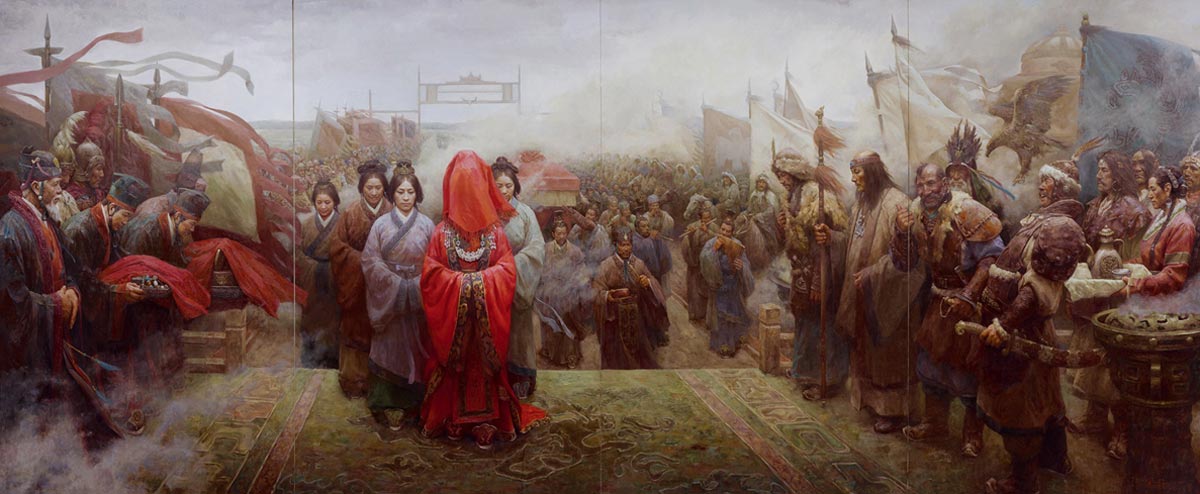 Wang Zhaojun (with the red veil) amongst the Huns. en.wikipedia.org/wiki/Wang_Zhaojun#Life_with_the_Xiongnu
|
|
Deleted
Deleted Member
Posts: 0
|
Post by Deleted on Oct 3, 2017 9:52:03 GMT -5
Sci-Fi/Fantasy Fiction of the Steppe. Piers Anthony, with an introduction by Chris Roberson, Steppe, Paizo Inc., 2010. (originally published in 1976) Piers Anthony, with an introduction by Chris Roberson, Steppe, Paizo Inc., 2010. (originally published in 1976)
Description:
After facing a brutal death at the hands of enemy tribesmen upon the Eurasian steppe, the 9th-century warrior-chieftain Alp awakes in a world of “demons”—sinister businessmen who have brought him fifteen hundred years into the future to make him a soulless pawn in a ruthless game that spans the stars. Based on secret records of Earth’s past, the Game sets players in the roles of historical figures, pitting them against one another in a decadent and deadly fight for supremacy. For Alp, however, war is never a game. With his own execution imminent, Alp must adapt quickly to both his new century and the strange rules of the Game world, facing off in bloodthirsty battles against the most notorious figures in history. For if Alp doesn’t emerge victorious, he’ll never live to claim the woman he loves... Review: yellowedandcreased.wordpress.com/2010/02/01/steppe-piers-anthony/
|
|
Deleted
Deleted Member
Posts: 0
|
Post by Deleted on Oct 9, 2017 14:15:38 GMT -5
The Story of the Mongols: Whom We Call the Tartars, by Friar Giovanni DiPlano Carpini , translated with an introduction by Erik Hildinger.  Description: Description:
Except for Marco Polo (whose book entitled, The Million, meaning a million lies about a fabulous China), Europeans knew very little about China. When the Mongols pushed out of China in their conquests to the west, suddenly the Europeans were faced with a veritable threat. In 1241, Mongols had killed more than 100,000 knights and soldiers in Russia, Poland and Hungary. In addition, the invaders laid waste to the land like no other force in history. Pope Gregory IX, understanding too well the threat of doom, was helpless because Europe knew nothing about those invaders; worse, there was no standing army to meet the challenge. The Pope put together a team of missionaries to go to China with the secret mission of gathering appropriate intelligence to bring back. Friar Giovanni Carpini did exactly that. He went to China, gathered the information, wrote them down in Latin, and presented them to the Pope. His extensive report, however, was never published.
The present English translation by Hildinger is the first ever to be published in English, and may still be one of a kind in the world. www.amazon.com/Story-Mongols-Whom-Call-Tartars/dp/0828320179
|
|
Deleted
Deleted Member
Posts: 0
|
Post by Deleted on Oct 10, 2017 14:15:25 GMT -5
Amazonian Warriors of the Steppe: Jade and Coral encrusted Jewellery of Hunnic Women Warriors.Words and pics by Sergey Zubchuk and Anna Liesowska siberiantimes.com/science/casestudy/news/chic-womens-jewellery-made-of-coal-encrusted-with-jade-and-coral-from-2200-years-ago/Eyecatching belt buckles worn by Xiongnu female invaders is found buried on the banks of the Yenesei River in modern-day Tuva Republic. 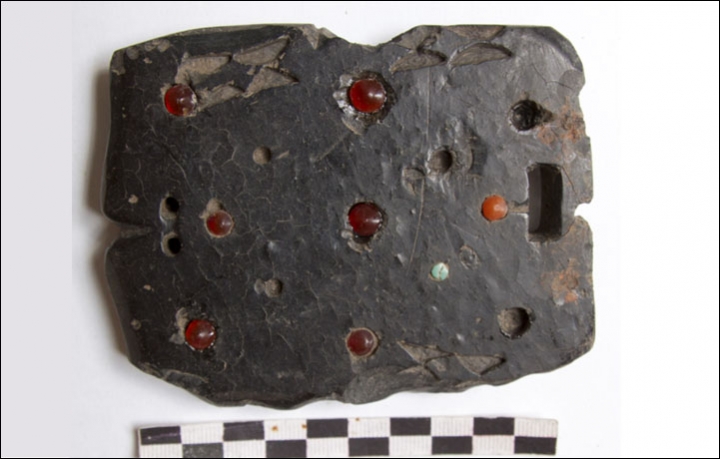 'Another buckle was encrusted with carnelian, jade, coral and turquoise.' Picture here and below: Marina Kilunovskaya 'Another buckle was encrusted with carnelian, jade, coral and turquoise.' Picture here and below: Marina KilunovskayaWomen buried in a unique ancient necropolis went to the afterlife wearing intriguingly decorated belt buckles made of coal, new archeological finds have shown. They were also adorned with flame-shaped bronze decorations on their shoulders. In addition, they wore magnificent bronze buckles on their belts, while Xiongnu men wore buckles mainly of iron. The buckles are artistically decorated depicting fantastical animals such as dragons as well as leopards, panthers, horses, yaks and snakes. 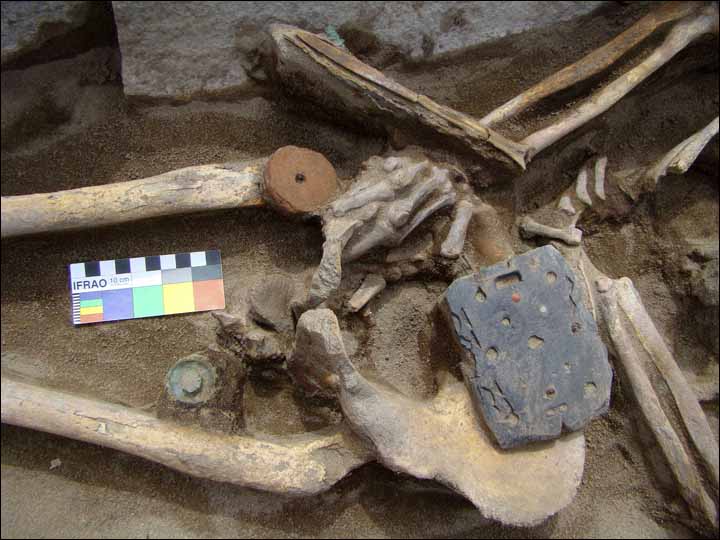 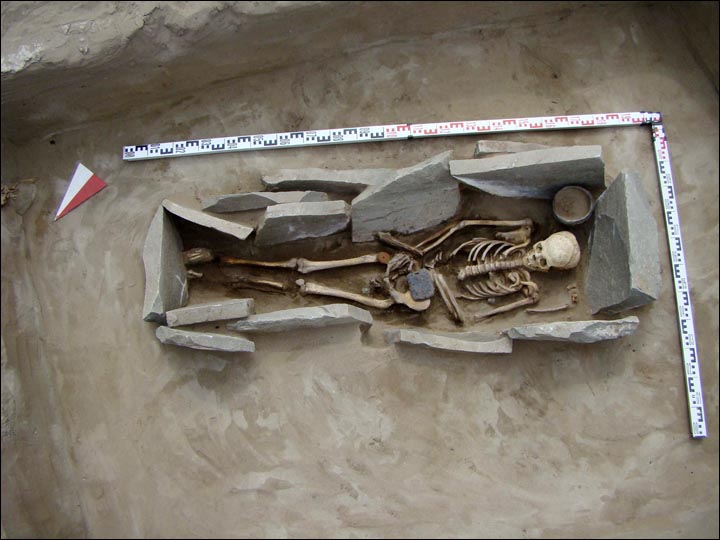 The women-only buckles made from coal are large - up to 20 cm in diameter. The women-only buckles made from coal are large - up to 20 cm in diameter.
|
|
Deleted
Deleted Member
Posts: 0
|
Post by Deleted on Oct 10, 2017 14:19:47 GMT -5
Amazonian Warriors of the Steppe: Jade and Coral encrusted Jewellery of Hunnic Women Warriors, part 2.'The most interesting and richest finds are in the women's graves', said Dr Marina Kilunovskaya, who led the expedition to the Ala-Tei burial ground on the Yenisei River in the Republic of Tuva. The women-only buckles made from coal are large - up to 20 cm in diameter, decorated with carved animal images or beautifully encrusted with semiprecious coral, carnelian, turquoise, and jade. 'On one of the buckles you can see engravings,' said the scientist. 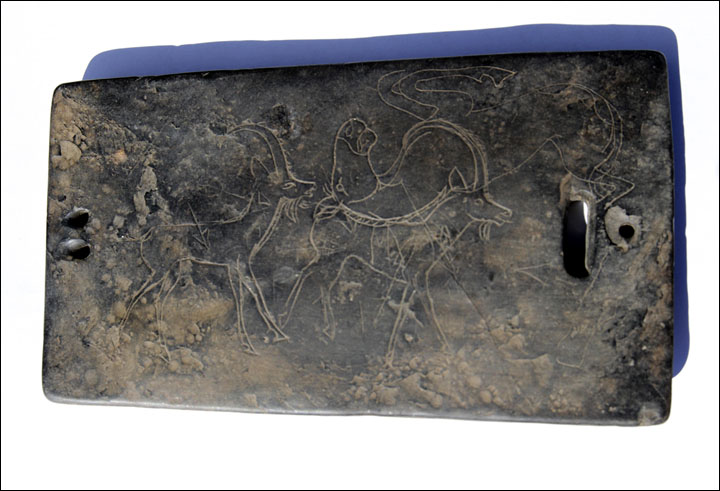 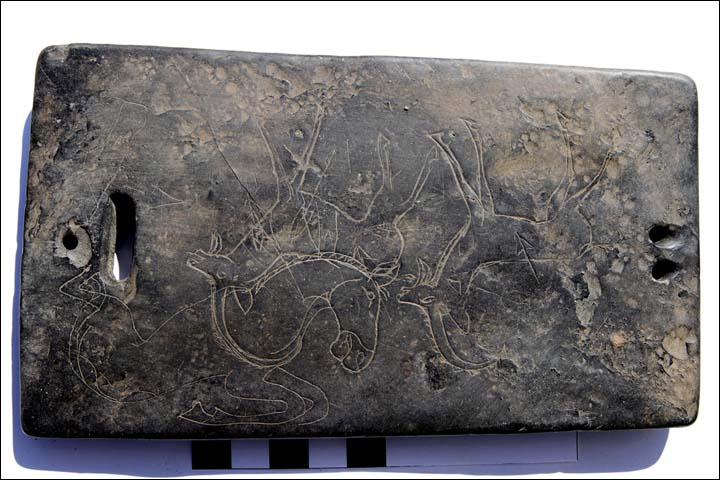 On one of the coal buckles can be seen Scythian-style engravings. On one of the coal buckles can be seen Scythian-style engravings.
On one side are two goats and arrows that pierce them. On the other, a horse is depicted in Scythian style. 'Another was encrusted with carnelian, jade, coral and turquoise.' She said: 'Evidently, their owners were very rich people who came from Trans-Baikal region or Mongolia. They found this material, it was interesting for them, and they used it for their decorations.' 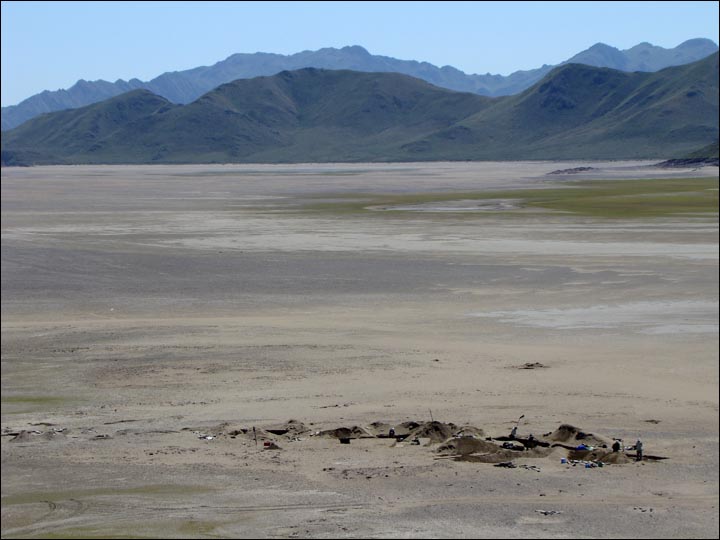 Ala-Tei burial ground located on the Yenisei River in the Republic of Tuva. Ala-Tei burial ground located on the Yenisei River in the Republic of Tuva.
|
|
Deleted
Deleted Member
Posts: 0
|
Post by Deleted on Oct 10, 2017 14:25:27 GMT -5
Amazonian Warriors of the Steppe: Jade and Coral encrusted Jewellery of Hunnic Women Warriors, part 3.'Most of the remains here belong to women. 'My colleagues often describe Xiongnu as big warriors, invaders. 'But these invaders, as you can see, are women in fact' - and they came northwards from the borders of modern-day China. 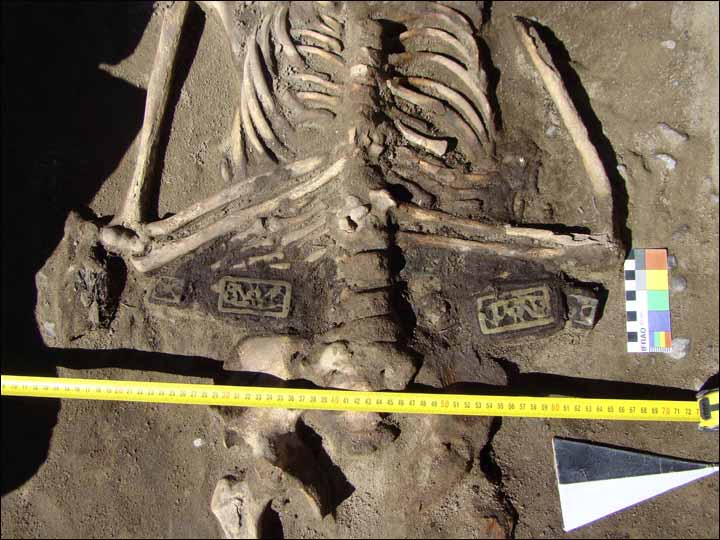 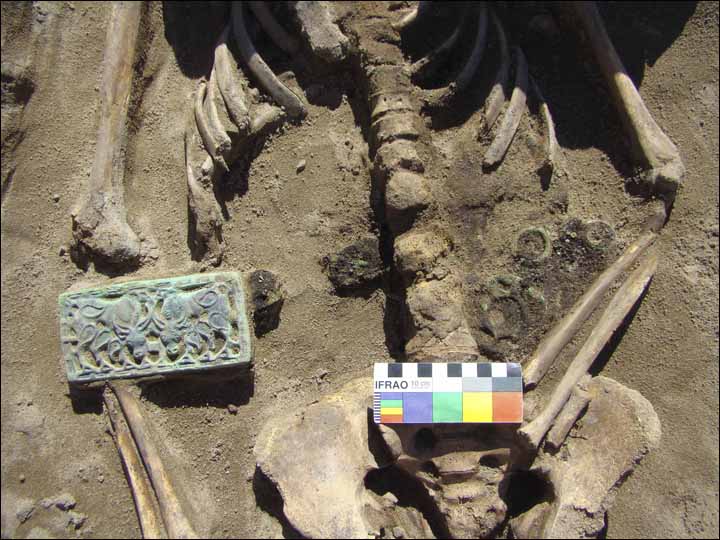 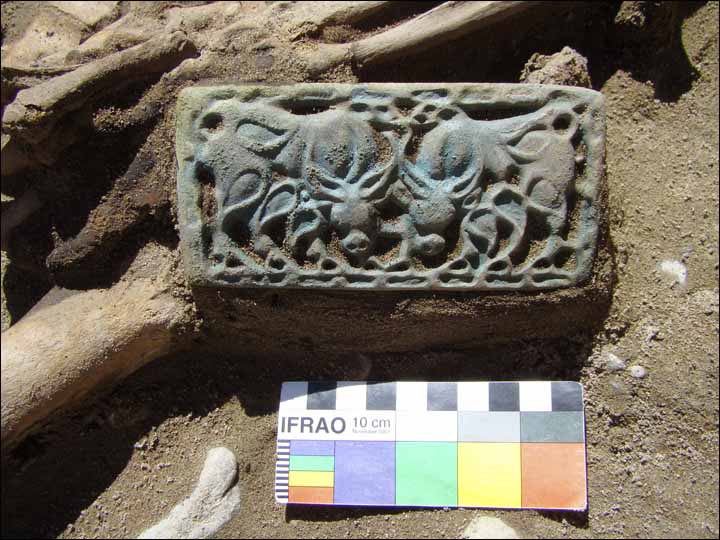 'First of all, in the central element of the belts are large bronze buckles with the image of animals - bulls, camels, horses, and snakes.' 'First of all, in the central element of the belts are large bronze buckles with the image of animals - bulls, camels, horses, and snakes.'The coal belt decorations worn by the women warriors 'were not for everyday use, of course, but for some special occasions, like weddings or funerals', she believes. There are only ten such coal buckle decorations in the world 'and here we have four', with all being native to Siberia, said Dr Kilunovskaya, of the Institute for the History of Material Culture, Russian Academy of Sciences, in St. Petersburg.  They were also adorned with flame-shaped bronze decorations on their shoulders. They were also adorned with flame-shaped bronze decorations on their shoulders.
|
|
Deleted
Deleted Member
Posts: 0
|
Post by Deleted on Oct 10, 2017 14:29:58 GMT -5
Amazonian Warriors of the Steppe: Jade and Coral encrusted Jewellery of Hunnic Women Warriors, part 4'I started excavations in 2015, and there are 80 burials here with no mounds,' she told The Siberian Times. 'Most of the ancient people are buried in rectangular stone boxes, sometimes boat-shaped, or in wooden coffins or frames, with a stone covering. 'Some burials are without any construction inside. 'Many include the heads of horses. 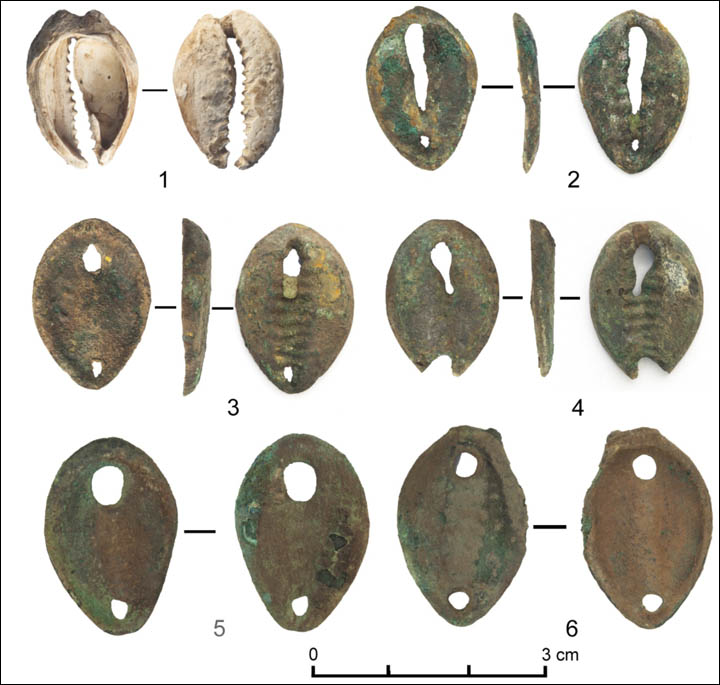 Bronze imitations of cowrie shells. Bronze imitations of cowrie shells.'Obviously, there was horse skin, too, which has not preserved - so only the skull and hooves survive.' 'First of all, in the central element of the belts are large bronze buckles with the image of animals - bulls, camels, horses, and snakes. 'Other details of the female belt, in most cases, are also made of bronze - these are rectangular hexagonal plaques, bronze imitations of cowrie shells, simple and openwork rings, and Chinese Wu Shu coins. 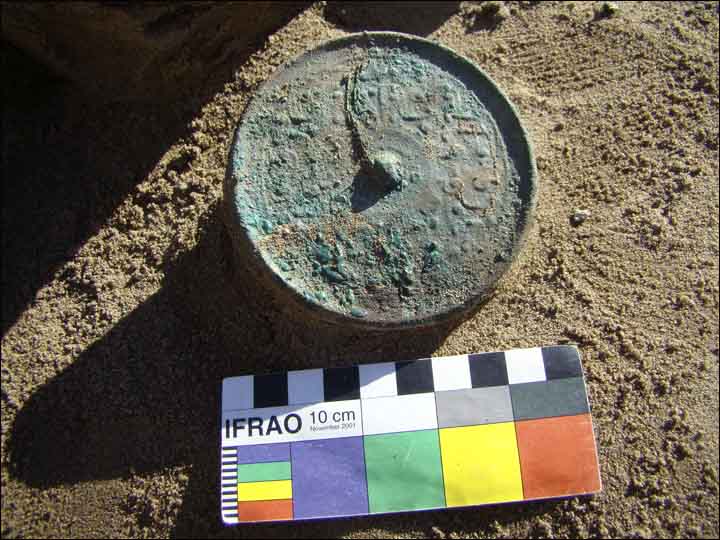 'Most of them are the early mirrors of the Western Han Dynasty (II-I centuries BC).' 'Most of them are the early mirrors of the Western Han Dynasty (II-I centuries BC).'
'We found whole bronze mirrors or their fragments. 'Most of them are the early mirrors of the Western Han Dynasty (II-I centuries BC), but there were fragments of two earlier Chinese mirrors belonging to an earlier period.' On male remains there were 'iron buckles on the belts'. Finds included buckles for shoes, knives, iron rings and hooks.
|
|
Deleted
Deleted Member
Posts: 0
|
Post by Deleted on Oct 10, 2017 14:38:57 GMT -5
Amazonian Warriors of the Steppe: Jade and Coral encrusted Jewellery of Hunnic Women Warriors, conclusion.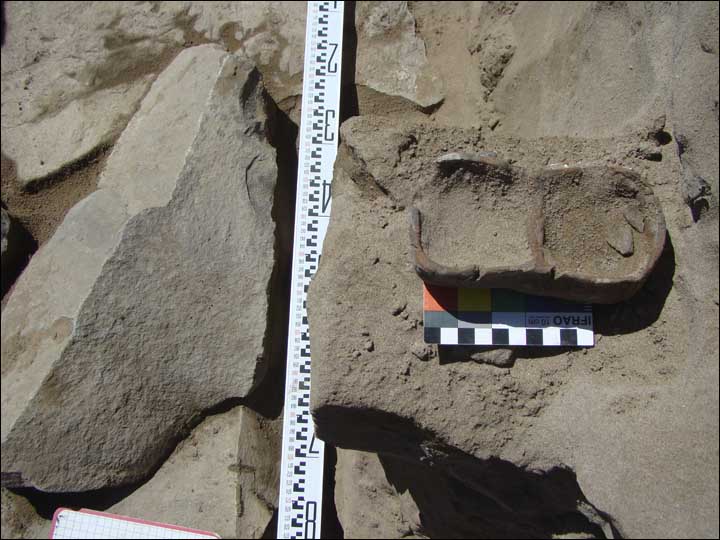 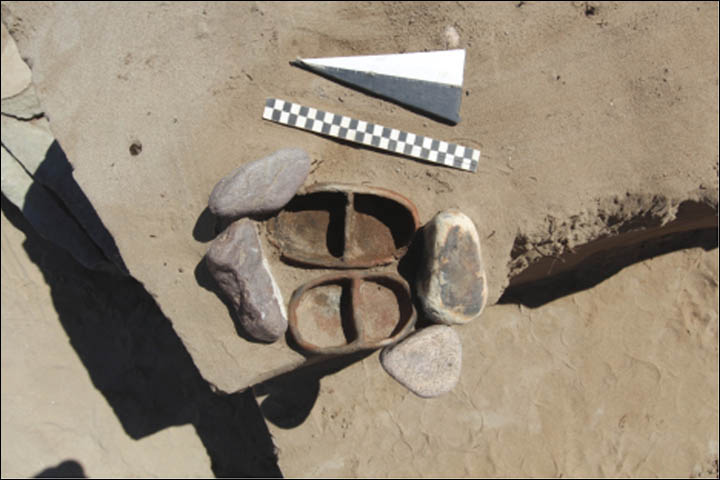 'These were located right above the graves. I believe these were kind on lamps.' 'These were located right above the graves. I believe these were kind on lamps.'
'Another interesting find in the graves were strange small flat vessels separated in the middle by a septum with an opening in the centre,' she said. 'These were located right above the graves. I believe these were kind on lamps.' Dr Kilunovskaya admitted: 'Actually... I'm afraid to give this interview, because when the general public learns about such an archaeological site... we may find 'black diggers' coming. 'The only hope is that it is hard to reach this place. 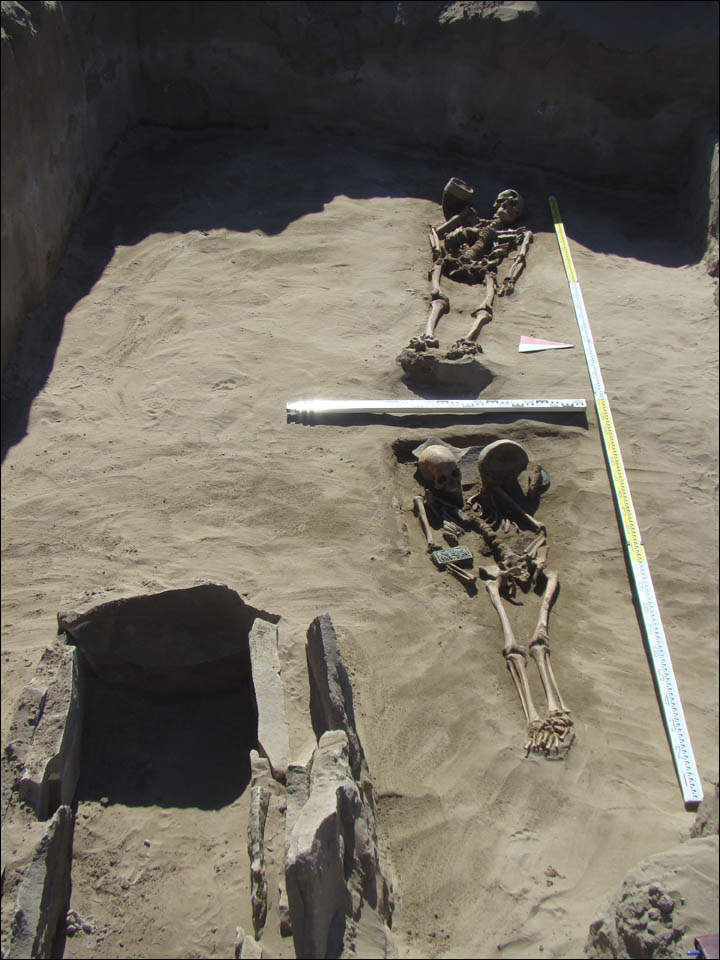 'There are quite a lot of burial grounds in this area - dated from Scythian times to the Middle Ages (2nd century BC to the 12-13th centuries) and they are being destroyed by water. 'When we came here for the first time, we saw a lot of skulls under a steep river bank and green bones there. 'Green because there was bronze items in burials. This looked terrible... So we try to save what we can.' Due to climate conditions, work here can only go ahead during the summer months and more research will be undertaken next year. 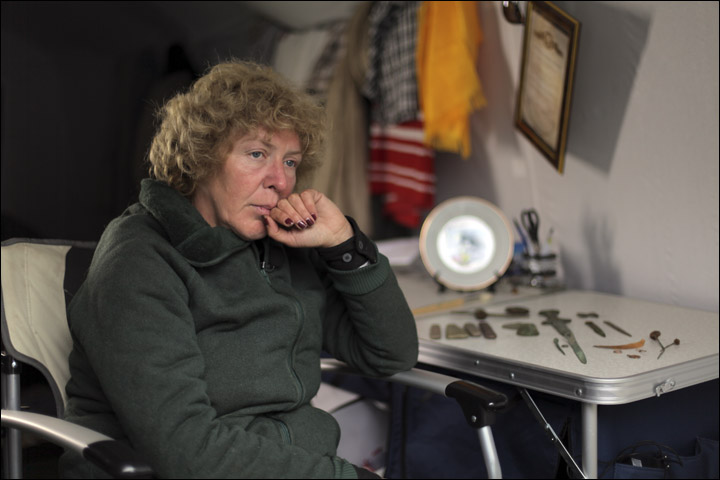 Marina Kilunovskaya Marina KilunovskayaShe describes the finds as 'the richest belt decorations'. 'The belt is the main attribute of the nomads, so it was richly decorated with various plaques - mostly of bronze, but also coal.' The Xiongnu were confederation of nomadic peoples who, say ancient Chinese sources, inhabited the eastern Asian Steppe from the 3rd century BC to the late 1st century AD.
|
|
|
|
Post by deuce on Oct 17, 2017 0:32:33 GMT -5
Amazonian Warriors of the Steppe: Jade and Coral encrusted Jewellery of Hunnic Women Warriors.Words and pics by Sergey Zubchuk and Anna Liesowska siberiantimes.com/science/casestudy/news/chic-womens-jewellery-made-of-coal-encrusted-with-jade-and-coral-from-2200-years-ago/Eyecatching belt buckles worn by Xiongnu female invaders is found buried on the banks of the Yenesei River in modern-day Tuva Republic. 'Another buckle was encrusted with carnelian, jade, coral and turquoise.' Picture here and below: Marina KilunovskayaWomen buried in a unique ancient necropolis went to the afterlife wearing intriguingly decorated belt buckles made of coal, new archeological finds have shown. They were also adorned with flame-shaped bronze decorations on their shoulders. In addition, they wore magnificent bronze buckles on their belts, while Xiongnu men wore buckles mainly of iron. The buckles are artistically decorated depicting fantastical animals such as dragons as well as leopards, panthers, horses, yaks and snakes. The women-only buckles made from coal are large - up to 20 cm in diameter. A fascinating excavation. However, what evidence is there of these women being actual warriors? Heavy training with bows or swords leaves telltale traces on skeletons. How did the archaeologists determine that these women were full-time warriors? |
|
Deleted
Deleted Member
Posts: 0
|
Post by Deleted on Oct 17, 2017 11:45:33 GMT -5
Amazonian Warriors of the Steppe: Jade and Coral encrusted Jewellery of Hunnic Women Warriors.Words and pics by Sergey Zubchuk and Anna Liesowska siberiantimes.com/science/casestudy/news/chic-womens-jewellery-made-of-coal-encrusted-with-jade-and-coral-from-2200-years-ago/Eyecatching belt buckles worn by Xiongnu female invaders is found buried on the banks of the Yenesei River in modern-day Tuva Republic. 'Another buckle was encrusted with carnelian, jade, coral and turquoise.' Picture here and below: Marina KilunovskayaWomen buried in a unique ancient necropolis went to the afterlife wearing intriguingly decorated belt buckles made of coal, new archeological finds have shown. They were also adorned with flame-shaped bronze decorations on their shoulders. In addition, they wore magnificent bronze buckles on their belts, while Xiongnu men wore buckles mainly of iron. The buckles are artistically decorated depicting fantastical animals such as dragons as well as leopards, panthers, horses, yaks and snakes. The women-only buckles made from coal are large - up to 20 cm in diameter. A fascinating excavation. However, what evidence is there of these women being actual warriors? Heavy training with bows or swords leaves telltale traces on skeletons. How did the archaeologists determine that these women were full-time warriors? Yeah, fascinating excavation. I agree, from what I can ascertain there's no evidence proving these Xiongnu women were warriors. Nobility? probably yes. Warriors? I'm not so certain if that's the case. You're right concerning skeletons; in most cases the skeletons should demonstrate evidence of wear and tear to the shoulders, arms and hands with archers - also, contain wounds from battle that have healed, and possibly a fatal wound to the warrior. It's still early days maybe more evidence will come to light. In the Frozen Tombs of Mongolia video above these signs are evident in the male tomb of the Mongoloid Scythian warrior - there's no mention of battle scars or wear and tear with the Caucasoid female, although she died from a fatal wound. I think there's a temptation to romanticize the role of women on the steppe. Sure, they had a lot more freedom than the women living in the towns and cities and sometimes the women became warriors - there are plenty of examples in the historical records. But, I have yet to come across any evidence confirming that a whole unit of Amazonian warriors, say like 10,000 warriors (Tümen) or an Amazonian imperial confederacy ever existed on the steppe. |
|
Deleted
Deleted Member
Posts: 0
|
Post by Deleted on Oct 17, 2017 15:28:50 GMT -5
The Khüis Tolgoi Inscription: The Earliest written Mongolian?I'm a little apprehensive about posting this, I've yet to find something in English online to confirm the news. Apparently this discovery was presented at the 60th Annual Meeting of the Permanent International Altaistic Conference (27 Aug-01 Sept, 2017) held in Székesfehérvár, Hungary. But if true, it is sensational news for Mongol and Altaic studies. The Khüis Tolgoi Inscription dates from the 1st Türk Empire 552-634 in Mongolia. If the Brahmi script on the stele is confirmed as Mongolian. It predates the earliest extant written Mongolian by six centuries! And even predates the Turkic runes of Mongolia by a century!! According to the translation (see below) the inscription glorifies Niri Kaghan (579- 603?) of the Türks. Could the founding fathers of the Türks be of Mongolian origin! It's a possibility. Transliteration according to Dieter Maue:(01) bı̣tı̣1-ña̤r kagan digi1n šı1̣ñıṇ bodı-satva to̤ ro̤ x (02) kagan bṳda̤ kaganu ukax ukaǰu xı1̣rı ̣ añakay (03) ...ı̣1 tı̣1n ǰa̤ x bo̤dı̣ bigiy-ñär ba̤yı̣ do̤ lṳǰa̤ ǰṳ hügbü[ ? ] (04) +? b[ı]̣ tı1̣ ǰı1̣ lo̤na̤ r k(a)ranyaguñ tṳwa̤ pṳro̤r čıč̣ ı1̣ ra̤ pügti1g ña̤ la̤n (05) × k ga[nu?] + kato-ñar dügi1d nı1̣rı ̣ kagan türǖg kagan
(06) uč d(o̤ )ro̤ ta̤ya̤ǰṳ xı1̣rı ̣ härgin bargo[l] pa̤ lxı1̣r [+]xa̤ čı ̣ hi1gbi1ǰ
(07) tügǰü ukabar-ñar kagan xa̤nı ̣ ǰṳla̤ba̤ tṳnṳ tügnyä tṳwa̤
(08) + xa̤ [] tṳ[] to[go?]gun pügtigči śı1̣ ñıṇ bodısatva to̤ ro̤ x kagan
(09) [+]l[] + []ı̣yṳ uč biti1hi1ñ + + gux tṳwa̤ -ña̤r kagan to̤ro̤ x kaganun
(10) + pa̤da̤ n<ı1̣ >rı ̣ kagan türüg [ka]ga[n] []ı1̣ ǰıṇ ubı1ǰ ǰa̤ lo̤ba̤ ǰ darkad ǰa̤yabı
(11) [ ? ]rṳn bitig + säg pag [ + + ] j[] [ ? ] darkan ba | tı̣ ba̤ ka
[blanco]
109 OrHere's a partial translation by Alexander Vovin:1-3. qaɣan [and] prince [of] the inscriptions. When qaɣan, who will be [re]born as a new Bodhisattva, knows lord Buddha knowledge, and promises to the country’s Ańaqay [title], begs, stand for the tribe, and promising seven [times] … 4. Looking at the inscription stones, Tupa [people], … in order to stab … joining … 5. … qaɣan’s wives [and] younger brothers, [and] Niri qaɣan, qaɣan [of] Türks 6. worshiped the Law, and country’s erkins and collectors … 7. is enough and there were enough of those who realized that qaɣan’s regnal years were shining. Tupa 8. people … counting … qaɣan who will be [re]born as a new Bodhisattva9-10. … of the inscription … Tupa persons being cut from the qaɣan who will be [re]born as a qaɣan, [they] followed Niri qaɣan, qaɣan of Türks and … [He] directed [them]. Free men were happy. 11. Official … wrote this inscription …
|
|
Deleted
Deleted Member
Posts: 0
|
Post by Deleted on Oct 17, 2017 16:09:57 GMT -5
I have managed to find the schedule for The Permanent International Altaistic Conference (PIAC) and there appears to be a whole morning (Thursday 31) devoted to the Khüis Tolgoi Inscription, with contributions from Dieter Maue and Alexander Vovin among others. Anyway, it's kinda interesting to see what the Altaic scholars are up to these days. Here's a link to the Permanent International Altaistic Conference (PIAC) website: www.altaist.org/piac/ |
|
Deleted
Deleted Member
Posts: 0
|
Post by Deleted on Oct 24, 2017 12:59:54 GMT -5
Historical Fiction of the Steppe: Year of the Horsetails by R. F. Tapsell. I really loved this book, and have been seeking a copy for years. I really can't find the words in Hunnic or in English to relate how fantastic this book is. Here's a great review by Morgan Holmes (docpod).
Review:
R. F. Tapsell’s The Year of the Horsetails is the greatest novel you have never read. It ranks probably in my top five favorite novels alongside The Hour of the Dragon, The Broken Sword, and Eagle in the Snow.I first heard of it in a book review by L. Sprague de Camp in an issue of Amra. He complained of the military aspect to the novel. Well, that would make sense as R. F. Tapsell (1936-1984) had served in the Royal Air Force as a Russian translator for intelligence. He had a B.A. from the School of Slavonic and East European Studies at London University.Tapsell wrote three historical novels and one non-fiction book on European royal dynasties. The Year of the Horsetails (1967) was his first novel. It is set in Eastern Europe at the juncture of the Eurasian steppes and the Carpathian Mountains.The time is somewhere in the early Middle Ages, probably between 700-900 A.D. The Slavs have expanded from their birthplace of the Pripet Marshes region. The Germanics have vacated Eastern Europe in the folk wandering. The Byzantines are mentioned. The Magyars had not arrived yet.Tapsell has the time deliberately vague. If you have ever read Harold Lamb, especially the excellent March of the Barbarians, you know that Eastern Europe was buffeted by waves of Turco-Mongol steppe nomads over the centuries. This novel is almost historical fantasy though no supernatural or magical elements are present.This is a novel of genocidal warfare. The Turco-Mongol Tugars raid an area, virtually depopulating the native population. Those not killed are sold in slave markets in Central Asia, probably to the Moslems.The novel starts with Bardiya escaping from the Tugars. He is a chieftain of the Sakas, an Aryan people tributary to the Tugars. He takes refuge with the Slavic Drevich tribe. He warns the Drevich that the Tugar are coming their way like an avalanche and attempts to aid in preparation.There is a great battle sequence showing how infantry armies would lose to steppe nomad horse archers. A portion of the book is dedicated to an epic siege, one of the best I have ever read.The climax is exciting and satisfying. This book keeps you turning the pages. 5 of five rating.There was a paperback edition from Berkley in 1968. I have never seen a copy at a used bookstore. It does show up on E-bay once in a while. Luckily there was a reprint edition in 2013. Amazon has a Kindle edition for $2.99.Tapsell’s other two novels are about the Greek Islands after the Fourth Crusade (The Unholy Pilgrim) and a novel about Darius and the Persian Empire (Shadow of Wings). All are worth reading.Link to review: www.castaliahouse.com/the-year-of-the-horsetails/
|
|
Deleted
Deleted Member
Posts: 0
|
Post by Deleted on Oct 26, 2017 17:25:53 GMT -5
|
|
Deleted
Deleted Member
Posts: 0
|
Post by Deleted on Oct 31, 2017 2:35:23 GMT -5
How Imperial Women Shaped the Mongol Conquests and the Mongol Empire by Anne Broadbridge.
The epic story of Genghis Khan and the Mongol conquests of Eurasia generates widespread interest, yet still today few know the truth of the matter. Still harder to find are the stories of Genghis Khan's womenfolk, even though no one doubts that there were many, many women in his life. In this lecture, Professor Broadbridge will present three key moments from Mongol history to illustrate the way that imperial women's contributions have dramatically changed Mongol history as we know it.
Anne F. Broadbridge is an Associate Professor of medieval Islamic history at the University of Massachusetts Amherst. She is currently finishing her second book, Imperial Women in the Mongol Empire. Her first book was Kingship and Ideology in the Islamic and Mongol Worlds (Cambridge, 2008). Her research focuses on two fields: first, the Mamluk Sultanate, with a particular interest in diplomacy and ideology; and second, the Mongol Empire, especially ideology, women and politics. She teaches on the Mongols, the Crusades, the Ottomans, early Islamic History, and Islamic Thought.
|
|























